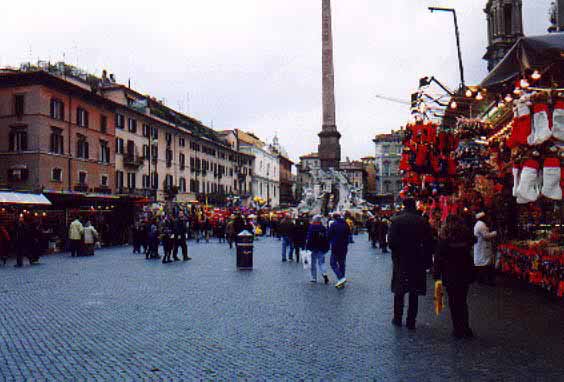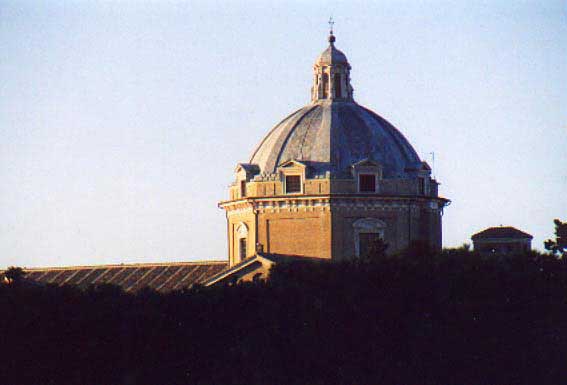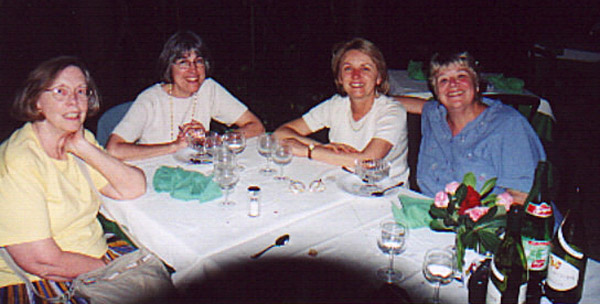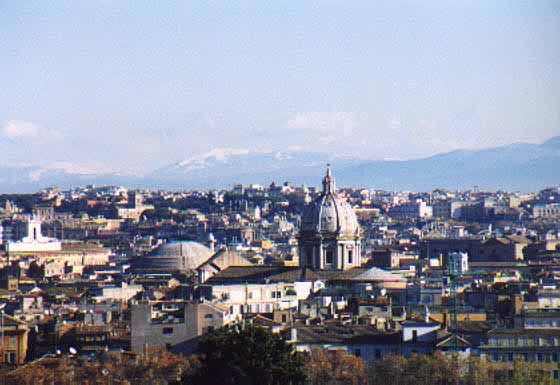| Deborah Stott | Letter from Rome, 29 November 1998 | |
|
Piazza Navona at Christmas
Il Gesù at sunset
Dinner in Rome
Ciao Roma. |
It's Sunday morning after Thanksgiving, I've gone out and had my morning double-espresso coffee and corneto, and read my favorite newspaper (La Repubblica - a left-wing, slightly overheated rag that I've been reading for years), so I thought I'd take a few minutes and report in on my adventures in Rome First of all, I have to admit that I've taken Linda's advice and slacked off work this past month. What she actually said was that I should take time for myself, which I interpreted liberally to mean that I didn't have to work as hard. I've done a lot more walking, which necessarily means that I've been spending a lot more money, since the walking is done in the city where there are stores and lots of things to buy, quite different from Urbania. Also, it's that season: preparation for gift-giving. And as a consequence, some of the walking has been to the post office, where I was reassured to find that some things in Italy don't change, the functioning of Italian post offices being a case in point. I know that this will particularly delight Jerry, whose notion of order was seriously offended by his experiences in a post office in Florence many long years ago. My local post office in Rome has progressed to the point where there is now a mandatory line for paying bills (electric, gas, etc.), but they've not felt this necessary for ordinary postal services, so for these the procedure is still to join a line very loosely-defined, really a crowd, and then try to hold position until you can claim your turn at the window. Of course the first challenge upon entering a post office is to determine the correct window for your transaction and in this your first choice will always be wrong. It's simply a given. I, for example, was mailing packages and so I went to the window marked "packages" (actually all signs, as testimony to the office's need to retain maximum adaptability and flexibility, are always hand-written on what appear to be scraps of paper taped or pasted to the clerk's window). After several minutes behind a gentleman who appeared to be mailing a trolley-full of identical packages, I was waved over one line and joined the milling group of those who were there for everything from buying stamps to sending money-orders. After fighting off a valiant rear-guard attempt by a little old lady in black to beat me to the window, I finally had my turn and managed to pass the three smaller packages between the counter and the glass; the fourth, however, was too big and this one had to be taken down to a security compartment - you open a door, put your package in, close the door and then the post office person opens the door on her side and takes it out. Unfortunately, this means yielding your physical place at the window for a few seconds and is, therefore, very dangerous. While I was gone, a person behind me had the chance to catch the clerk's attention and I had to wait awhile when I got back until that was finished. I have to admit that the process whereby the exact cost of mailing an item is calculated fills me with awe. First it is put on a scale and the clerk makes note of the weight and taps something into a calculator, then she looks at several different charts, all in different places on her counter, and after each taps more information into the calculator, then she realizes she has forgotten something and has to check the weight again and goes through the same procedure, though it seemed to me with different charts, and finally this operation yields an amount that she writes on the package. Then comes the challenge of finding the equivalent of that sum in stamps - no printing out a computer-generated postal authorization here. Stamps are kept in books, with sheets of stamps paper-clipped to different pages. The clerk quickly riffles through the pages to find out what stamps are available - most of the pages are always empty - and then she tears out an assortment that will eventually add up to the sum noted on the package. Since postage is quite expensive (several thousand lire for a small package) and since the largest stamp seems to be for one thousand lire, this winds up being a little pile of stamps which will cover almost the whole top surface of the package. Once this has been accomplished - for four different packages in this case - she returns all the packages, together with the appropriate piles of stamps, to me (this again requires the perilous trip down to the security door), gives me a grand total to pay and we're done. But now it's up to me to attach the stamps to the packages. Since there is no separate surface for this part of the operation, you're forced to move down the counter a bit, trying not to spill the stamps, out of the main flow but still in direct contact with it. Then you have to match up the stamps with the amounts written on the packages - okay, I have a Ph.D. and I can do that - and attach them. There is a conveniently-located little sponge to wet the stamps but it was dry, so I began by licking the first one. Two things: the adhesive quality of Italian stamps is always a little iffy and I wasn't able to make all of it stick, plus some of the area on which stamps had to be put had scotch tape on it. When the man next to me saw me do this, he suggested that it was very unhygienic and I should do it with glue. So I managed to get someone's eye and asked for the glue pot, which was promptly sent out to me. How long has it been since any of you has experienced a real glue pot? Not a neat little glue stick, such as we are all used to now, but a glass pot filled with glue, with a long-handled brush projecting from it. Apart from getting a fair amount of glue on my fingers and covering a small part of the addresses with stamps, this worked fine, and I was able to complete my journey to the post office successfully by sliding the small packages under the glass back to the clerk and making one more trip to the security door for the larger one. Trips to the post office always fill one with a tremendous feeling of accomplishment once one is back outside. On the other hand, one dreads the prospect of repeating the exercise, but it's always necessary since I'm sending not only some packages of Christmas presents but also books and some other stuff I don't want to tote. I have to say that it wasn't that way at all in Urbania. The post office there was quite large, with separate tables for tasks such as attaching stamps, and there was never a line when I went in. The clerk took the packages, totted up the cost, attached the stamps, and received my money in a matter of minutes, with no untidy passing of the packages back and forth, no glue, no muss, no fuss. Remarkable, really. Coming back to walking, some of it has been to museums and churches and the like, so that can sort of count as work, or at least as professionally-related. I went to a wonderful exhibition of 17th century Baroque paintings from the collection of Sir Denis Mahon, an English art historian/collector who almost single-handedly brought Baroque painting back as a scholarly and aesthetic field. The collection is quite wonderful and, as it happened, on the day I went he was there, taking a group of Italian friends around the exhibition. He's quite elderly and walks with a cane but exhibited a wonderful enthusiasm for the pictures, which was very charming. Another 17th century show has just opened, paintings by the French painter Poussin done when he was first in Rome, and it sounds very nice. This doesn't quite make up for the fact that most of the stuff that lives permanently in Rome is covered up for restoration because of the Jubilee of 2000. A friend of mine is teaching a course in Baroque art for an American school here and she says that there isn't a single church - of those that form the nucleus of Baroque art and architecture - that isn't at least partly covered by scaffolding, either inside or outside or both. She's reduced to saying, `well, if you could see this. . .' Actually, this is another topic - I'm beginning to feel like the old curmudgeon column in the old New Yorker magazine - changing fashions of covering up restoration. In the old days, when a building or monument was under restoration, it was covered by green mesh matting, and the green mats were a constant and reassuring feature of the appearance of Rome. Now, in the true spirit of advanced 20th century capitalism, they're white and often carry advertising. The Jubilee is much in the news and commentary, because so much has been undertaken in the name of getting Rome ready for tens of thousands of visitors. In addition to the omnipresent restoration of monuments, there is a massive amount of road work going on, including construction of a pedestrian underpass near the Vatican (this construction was a feature of my first letter, I think, where I described getting my rental car from the office to where I was staying), but lots of other stuff too. Naturally, there is healthy skepticism (especially in the newspaper I read) about the likelihood of most of this being finished by 2000, as well as who is benefiting from it. It's hard for anyone who has been familiar with Rome for many years to imagine that it will all be ready and functioning on schedule. Last night at dinner, someone told a wonderful story that embodies the foundations of such skepticism. Last year there was a major overhaul of bus routes that was, presumably, meant to eliminate unnecessary overlapping and make things more efficient. Included in this overhaul was the addition of some new tramlines and several small (very cute) electric buses, designed to be more environmentally friendly. The trams seem generally to work okay, though what is one to make of the existence of two number 8 trams (actually an "8" and an "8/") with two different routes? As my friend said, there are so few trams in Rome, wouldn't you think they could have given them different numbers? But the cute little electric buses have routes so complicated (and ever-changing) that no one knows where to get them. Last summer, a friend and I went to the stop of one of them - she had taken it from that very stop only that morning - and waited in vain for one to arrive. Eventually, we saw one several blocks away turning into another street. It seems that between morning and afternoon, the route had been changed, but no notice had been left at the old stop. The story my friend told last night relates to one of the regular buses that comes to the Janiculum hill, where we live. This is one of the buses whose route was changed last summer. He rode it recently and noticed that it wasn't taking its normal route, thereby missing his expected stop. When he asked the driver whether it was going to that stop, the driver simply replied, "Not today." I've had several e-mail messages from my library friends in Urbania. One was a photograph of me with several of them that had been taken at the little party they gave on my last day. Apparently, they've acquired a scanner. And another was telling me about a snowfall they had had, which is unusual. Laura said that all traffic stopped, since the roads weren't plowed, and everyone put on their woollies and went out and played in the snow, making snowmen and throwing snowballs. OK, work. I've been doing some work in the Academy library, doing secondary-source reading and xeroxing, and I went to the State Archives one day to look up Cornelia's husband's will. I wrote some of you about this, so I'll just say this briefly. Thank Heavens that my work was in the Urbania archives - I could never, never have accomplished what I've been able to had I been working in the State Archives. Not that they aren't perfectly nice and all, but they have very strict rules: no more than 3 items a day, requests have to have two signatures (2 lines) and be handed in at specified times, no more than one item on your desk at a time. I would never have able to go through all the notaries' books I did if I had had to stay within these limits. But I did make an observation about the will that counts as interesting rather than really significant, one of those observations that you can only make if you go to the original object. The will actually exists in three different versions in the notary's book, and, naturally, only the most complete of these has been published. When you look at what seems to be the earliest version, you see that only Michelangelo is named as tutor of the children - the names of the two other men, from Casteldurante, which appear in the final version are written in the margin as an after-thought and then consolidated in the later versions. So at first, Michelangelo was the only executor, then apparently someone had second thoughts. Enough already. I have only a little more than 3 weeks left, which I find so hard to believe. The time has just flown and, though I think for the most part I've used it well, it does go by so quickly. I'll be in touch with many of you individually before then, but I'm sure this will be my last meandering group letter. |




